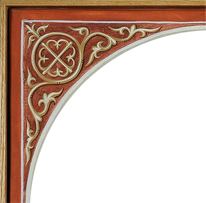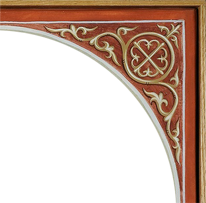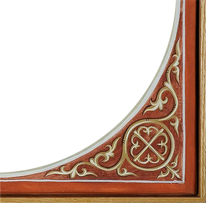In the Orthodox Church there is a religious and salutary custom, unfortunately not as widespread as it deserves. In many Churches, you cannot help observing how the faithful eagerly enter and there, by the Church doors, buy a Church loaf, or two, have it (or them) brought into the sanctuary, together with a paper (or a small book kept for the purpose, a “pomyanik”) upon which some names have been written. Then, after particles have been cut out from these breads, they take them again, and upon leaving the Church they bring the loaves home with them. During the great holy days, on the days when the dead are remembered, as also during Great Lent when a great may people receive the holy Sacraments of Christ, a large number of these Church breads are brought into the Altar.
Having received back their prophoron (church bread), or loaf, after a particle has been taken from it in the Altar, the faithful carefully handle it and, crossing themselves, they kiss it. Then, after the Liturgy they carry it to their homes and here, with all the members of the household, they eat it before they partake of their regular meal (i.e., upon an empty stomach). (In many Orthodox homes, the loaf is kept from Sunday to Sunday and a particle received by each member of the family each morning, together with a few drops of blessed water.)
Let us, first of all, mention the fact that five bread loaves are used (in the Slav practice) in offering the Divine Liturgy in the Orthodox Church. From the first one a conveniently large piece is cut and put on the paten, which at first is a representation of the Lord Jesus Christ; and after, during the Consecration, it is mystically changed into the true Body of Christ. Even so does the wine with water which was poured into the chalice during the offertory become at the same time the real and life-giving Blood of the Lord. This larger particle is therefore called the Holy Lamb.
From the second prosphoron, a particle is taken and put on the paten on the right side (of the Holy Lamb) ‘in honor and remembrance of the Most Blessed Lady and Mother of God.’
From the third, nine particles are cut and put on the left of the Holy Lamb on the paten, in honor and remembrance of the nine orders of the saints.
From the fourth prosphoron several particles are taken and put before the Holy Lamb, for the health and salvation of the living. First of all, the priest makes mention of the Orthodox patriarchs, and especially his own Metropolitan and Bishop, with all the clergy, and then he lays down upon the paten a particle. After this, another for Orthodox rulers and for all the living, and especially those (by name) who have asked to be remembered. At each name, the priest takes a small particle and puts it down before the Lamb.
From the fifth loaf particles are cut out and put on the paten in remembrance and for the forgiveness fo sins of all the departed, commencing with the patriarchs and kings. The priest makes mention of each departed one whom he wishes or whom he has been asked to mention by name, and for each he places a bit of the loaf before the Holy Lamb.
In this manner, parts are taken from the five breads, which are necessary in offering the Divine Liturgy.
To be continued next month



